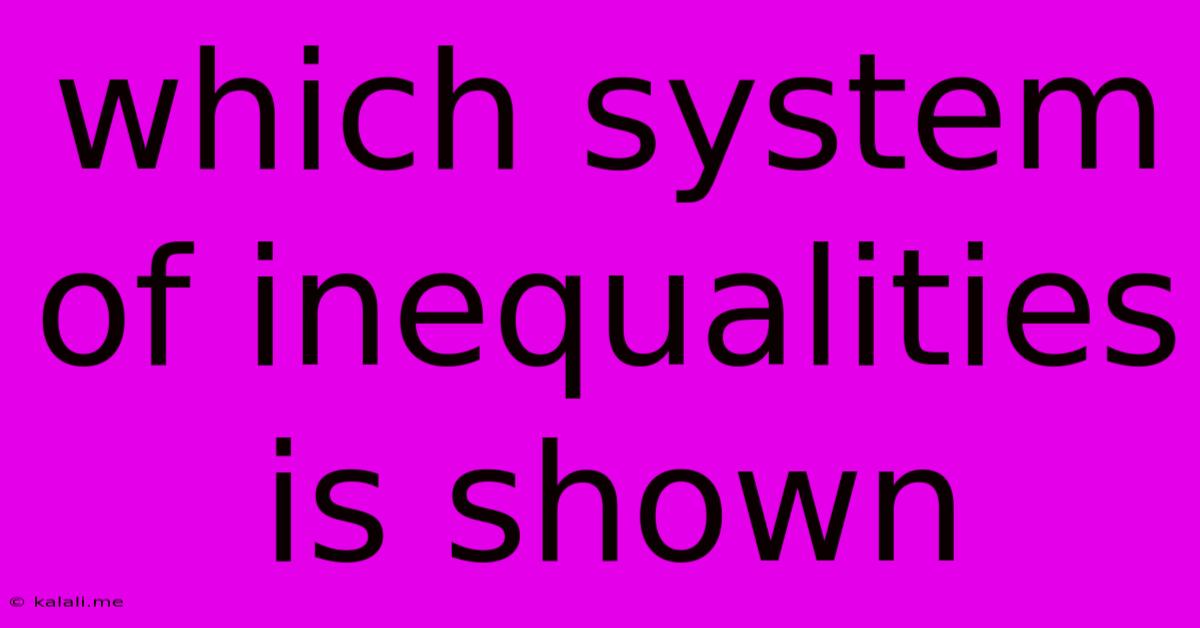Which System Of Inequalities Is Shown
Kalali
May 10, 2025 · 4 min read

Table of Contents
Which System of Inequalities is Shown? A Guide to Identifying and Graphing Systems of Inequalities
Understanding how to identify and graph systems of inequalities is crucial for anyone studying algebra or precalculus. This skill allows you to visually represent the solution set for a group of inequalities, offering valuable insights into the relationships between variables. This article will guide you through the process of identifying the system of inequalities represented by a graph and also explain how to graph them yourself.
What is a System of Inequalities?
A system of inequalities is a set of two or more inequalities that are considered simultaneously. The solution to the system is the set of all points that satisfy all the inequalities in the system. This solution set is often represented visually as a shaded region on a coordinate plane.
Identifying a System of Inequalities from a Graph:
When presented with a graph showing shaded regions, several steps can help you identify the corresponding system of inequalities:
-
Identify the Boundary Lines: Look for the lines that form the boundaries of the shaded regions. These lines represent the equality part of the inequalities (e.g.,
y = 2x + 1). Determine their equations using the slope-intercept form (y = mx + b), point-slope form, or by observing intercepts and calculating the slope. -
Determine the Inequality Symbols: Observe the shading.
-
Shading above a line: Indicates a "greater than" inequality (
>or≥). A solid line indicates "greater than or equal to" (≥), while a dashed line signifies "greater than" (>). -
Shading below a line: Indicates a "less than" inequality (
<or≤). A solid line indicates "less than or equal to" (≤), while a dashed line signifies "less than" (<).
-
-
Write the Inequalities: Combine the equation of the boundary line with the appropriate inequality symbol based on the shading to write each inequality in the system.
-
Test a Point: To confirm your inequalities, select a point within the shaded region and substitute its coordinates into each inequality. The point should satisfy all the inequalities in the system.
Example:
Let's say a graph shows a shaded region above a solid line passing through (0, 2) and (1, 5), and below a dashed line passing through (0, -1) and (1, 1).
-
Boundary Lines: The slope of the first line is (5-2)/(1-0) = 3, and the y-intercept is 2. Its equation is
y = 3x + 2. The second line has a slope of (1 - (-1))/(1 - 0) = 2 and a y-intercept of -1. Its equation isy = 2x - 1. -
Inequality Symbols: The shading is above the first line (solid), indicating
y ≥ 3x + 2. The shading is below the second line (dashed), indicatingy < 2x - 1. -
System of Inequalities: The system is:
y ≥ 3x + 2y < 2x - 1 -
Test Point: Let's test the point (2, 7). For the first inequality: 7 ≥ 3(2) + 2 = 8 (False). There appears to be an error in the original deduction. Let's re-examine the shading. If the shading is below the first line, it would be
y ≤ 3x + 2, making the point (2,7) a valid solution.
Graphing Systems of Inequalities:
To graph a system of inequalities:
-
Graph each inequality individually: Treat each inequality as a linear equation and graph it on the coordinate plane. Use a solid line for inequalities with
≤or≥, and a dashed line for those with<or>. -
Shade the appropriate region: Shade the region that satisfies each inequality. The solution to the system is the region where all shaded areas overlap.
Key Considerations:
- Bounded vs. Unbounded Regions: The solution region can be bounded (enclosed) or unbounded (extends infinitely).
- Corner Points: The points where the boundary lines intersect are often important in optimization problems.
- Linear Programming: Systems of inequalities are fundamental to linear programming, a technique used to optimize objectives within constraints.
By mastering the techniques outlined in this article, you'll gain a strong understanding of systems of inequalities, enabling you to confidently identify them from graphs and graph them yourself. Remember to always check your work by testing points within the solution region. This helps ensure accuracy and solidify your understanding of the concepts involved.
Latest Posts
Latest Posts
-
How Many Laps Around A Football Field Is A Mile
Jun 30, 2025
-
The Ability To Say Clever And Funny Things
Jun 30, 2025
-
How Many Cups Are In A Pound Of Lard
Jun 30, 2025
-
Why Did Jerry Thompson And Kelly Nelon Divorce
Jun 30, 2025
-
Allen And Roth Patio Furniture Replacement Parts
Jun 30, 2025
Related Post
Thank you for visiting our website which covers about Which System Of Inequalities Is Shown . We hope the information provided has been useful to you. Feel free to contact us if you have any questions or need further assistance. See you next time and don't miss to bookmark.